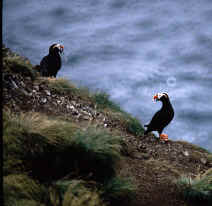
The
Tufted Puffins of Triangle Island are one of four species studied on Triangle
Island as part of the Centre for Wildlife Ecology seabird
research and monitoring program.Other
species include the Common Murres, Rhinoceros Auklets, and Cassinās Auklets.Dr.
Doug Bertram is the principle investigator of the program run jointly by
the Canadian Wildlife Service and Simon Fraser University.
Tufted Puffins (Fratercula cirrhata) are widely distributed throughout the North Pacific but are abundant only in British Columbia, Alaska and across the North Pacific into the Sea of Okhotsk. During the summer breeding months, the adults have dark bodies and wings, which sharply contrast with the red legs and feet, white face, and yellow filoplumes curling back from above the eyes.The bill is mostly orange-red with a greyish-green plate at the base.In winter, they lose their plumes, the white face transforms to dark, and the green basal plate of the bill is lost.Juvenile birds are similar in appearance to wintering adults but are more grey-brown in colour and have bills that are far less robust.Males and females are monomorphic.
Tufted Puffins are true seabirds as they spend all but 3 reproductive months at sea.Breeders are first seen circling the colony and rafting together offshore about a month before they lay their egg.Colony activity during this time involves nest site selection, burrow excavation and defence, and behaviours associated with pair bonding. Adults are thought to be monogamous and may return to the same burrow year after year.Once pairs have established nesting burrows, they lay a single egg that will be incubated by both the male and female for about 45 days.Young are semi-precocial.They hatch covered with down and are active, but dependent on their parents to feed them at the nest.For the first few days after hatching, the nestling is brooded until it can thermoregulate on its own.Both parents provision with a variety of fish and invertebrate species for approximately 45 days until the nestling fledges to feed independently at sea.
Triangle
Island
Triangle Island, the outermost of the Scott Island archipelago, lies approximately 45 km north west of Cape Scott, Vancouver Island.The island rises steeply from the rich intertidal up to the remnants of a lighthouse, 230 m above sea level.It is heavily vegetated but absent of trees.Joined at low tide to the western point of the main island is Puffin Rock, a steeply sloped islet rising to a height of approximately 100 m and home to most of the 25 000 breeding pairs of Tufted Puffins.